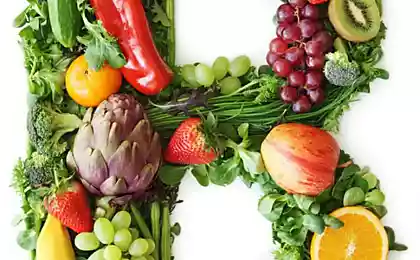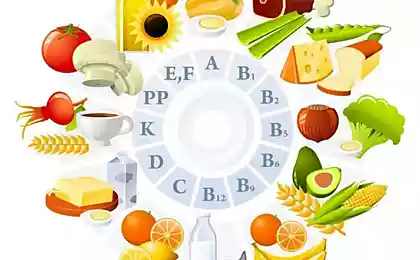540
How to preserve vitamins in foods

Vitamins are called organic compounds included in the composition of enzymes, regulators and catalysts of biochemical reactions. For the normal life they are needed in extremely small quantities: mg, or thousandths – mcg. The humans and animals they are not synthesized or synthesized in very small amounts. For this reason, vitamins must be regularly ingested with food. There are 13 known vitamins:
Fat-soluble: A (retinol), D (calciferol), E (tocopherol) K (phylloquinone).
Water-soluble: C (ascorbic acid), B1 (thiamine), B2 (Riboflavin), B5 (Pantothenic acid), B6 (pyridoxine), PP (Niacin), B9 (folate), B12 (cobalamin), H (Biotin).
The content of vitamins in the diet can vary and depends on different reasons: from the variety and on products, methods and timing of their storage, the nature of technological processing of food, food choices and eating habits. The important role played by the composition of the food.
The daily requirement of vitaminsthe Need for vitamins depends on age, sex, physical activity, presence of chronic diseases, level of metabolism. We recommend the following rate of consumption of vitamins. Category
Age
(years)
And
IU
And
mcg
E
mg
D
IU
mcg
To
mcg
With
mg
B1
mg
Infants
0-0,5
0,5-1
1250
1250
400
400
3
4
300
400
10
10
5
10
30
35
0,3
0,4
Children 1-10 years
1-3
4-6
7-10
1340
1670
2335
450
500
700
6
7
7
400
400
400
10
2,5
2,5
15
20
30
40
45
45
0,7
0,9
1
Teenagers and adults male
11-14
15-18
19-24
25-50
>50
3333
3333
3333
3333
3333
1000
10
10
10
10
10
400
400
400
200
200
2,5
45
65
70
80
80
50
60
60
60
60
1,3
1,5
1,5
1,5
1,2
Teenagers and adults female
11-14
15-18
19-24
25-50
>50
2667
2667
2667
2667
2667
800
8
8
8
8
8
400
400
400
200
200
2,5
45
55
60
65
65
50
60
60
60
60
1,1
1,1
1,1
1,1
1
Category
Age
(years)
B2
mg
B5
mg
B6
mg
Sun
mg
B12
mcg
RR
mg
N
mcg
Infants
0-0,5
0,5-1
0,4
0,5
2
3
0,3
0,6
0,025
0,035
0,3
0,5
5
6
10
15
Children 1-10 years
1-3
4-6
7-10
0,8
1,1
1,2
3
4
5
1
1,1
1,4
0,05
0,075
0,1
0,7
1
1,4
9
12
7
20
25
30
Teenagers and adults male
11-14
15-18
19-24
25-50
>50
1,5
1,8
1,7
1,7
1,4
4-7
4-7
4-7
4-7
4-7
1,7
2
2
2
2
0,15
0,2
0,2
0,2
0,2
2
2
2
2
2
17
20
19
19
15
30-100
Teenagers and adults female
11-14
15-18
19-24
25-50
>50
1,3
1,3
1,3
1,3
1,2
4-7
4-7
4-7
4-7
4-7
1,4
1,5
1,6
1,6
1,6
0,15
0,18
0,18
0,18
0,18
2
2
2
2
2
15
15
15
15
13
30-100
Special attention should be increasing 1.5 times the requirement of vitamins in women during pregnancy.
In modern conditions the future mothers not only do not receive additional amounts of vitamins, but have them moderate or deep deficit. For different vitamins, it can range from 45% to 100%. The most common in pregnant women a deficiency of vitamins B6 (100%), B1 (96%), folate (77%), vitamin C (64%).
And
E
mg
D
IU
In
mcg
With
mg
B1
mg
B2
mg
B6
mg
Sun
mg
B12
mcg
RR
mg
Pregnant
1000
10
400
12,5
90
1,5
1,6
2,1
0,4
4
16
Nursing
1200
12
400
12,5
110
1,7
1,8
2,3
0,3
4
19
Directory of vitaminsSources of vitamins of plant and animal origin:
Vitamin
Herbal products
Products of animal origin
And
Carrots, citrus
Butter, cheese, eggs, liver, fish oil
Beta-Carotene
Carrots, parsley, spinach, spring greens, cantaloupe, tomatoes, asparagus, cabbage, broccoli, apricots
D
Milk, eggs, cod liver oil, cod liver oil, fatty fish
E
Corn, sunflower, olive oil, peas, sea buckthorn
To
Green leafy vegetables, spinach, Brussels sprouts, belokochannaya and cauliflower, cereals from whole grains
B1
Dried brewer's yeast, pork, wheat germ, oats, nuts (hazelnuts)
B2
Yeast extract, wheat germ, wheat bran, soybeans, broccoli
Liver, egg yolk, cheese
RR
Green vegetables, nuts, cereals, whole grains, yeast
Meat, including chicken, liver, fish, milk, cheese
B5
Yeast, legumes, mushrooms, rice
Liver, meat by-products
B6
Sprouts and wheat bran, green leafy vegetables
Meat, liver, fish, milk, eggs
B9
Nuts, green leafy vegetables, beans, wheat germ, bananas, oranges
Eggs, organ meats
B12
Yeast, seaweed
Liver, kidneys, caviar, eggs, cheese, milk, cheese, meat, fish
N
Egg yolk, liver, kidney
How to preserve vitamins in foodsWith the predominance in the diet of carbohydrates the body requires more of vitamins B1, B2 and C. the shortage of food protein decreases the absorption of vitamin B2, nicotinic acid, vitamin C, impaired conversion of carotene into vitamin A. in addition, of great importance in the decrease of vitamins in the body is the use of highly refined products (sifted white flour, white rice, sugar, etc.), of which all the vitamins removed during processing. Another problem in human nutrition, especially in cities, is eating canned food.
Currently used in commercial agriculture cultivation techniques of vegetables and fruits has led to the fact that the amounts of vitamins A, B1, B2 and C decreased in many vegetable crops by 30%. For example, vitamin E almost completely disappeared from the lettuce, peas, apples, parsley. The amount of vitamins in spinach crops can be 30 times less than in the green of another crop. In other words, even strictly balanced diet may not always provide the body's need for vitamins.
The content of vitamins in foods can vary significantly:
When boiling milk, the amount of contained vitamins are greatly reduced.
An average of 9 months per year, Europeans eat vegetables grown in greenhouses or after a long storage period. Such products have lower levels of vitamins compared to vegetables from the open ground.
After three days of storing food in the refrigerator lost 30% of vitamin C (at room temperature the average is 50%).
During heat processing of food is lost between 25% and 90-100% of the vitamins. In light of the vitamins are destroyed (a very active vitamin B2), vitamin a exposed to ultraviolet rays.
Vegetables without a peel contains significantly less vitamins. Drying, freezing, mechanical treatment, storing in a metal container, pasteurization reduces the content of vitamins in the original product. The content of vitamins in fruits and vegetables varies very widely in different seasons.published
Author: Ruslan Bredikhin
P. S. And remember, only by changing their consumption — together we change the world! ©
Source: nkozlov.ru/distance/s201/d2488/#.VVBzJtrtmko























